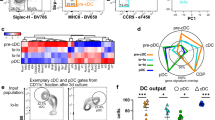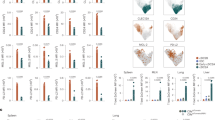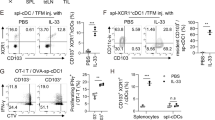Abstract
Immediate precursors of the many subtypes of dendritic cells (DCs) remain obscure. Here we purified a splenic precursor population that produced all splenic CD8+ and CD8− conventional DCs (cDCs) but not plasmacytoid DCs or other lineages. This 'pre-cDC' population included cells 'precommitted' to form either CD8+ or CD8− cDCs. The pre-cDCs, which comprised 0.05% of splenocytes, expressed a CD11cintCD45RAloCD43intSIRP-αintCD4−CD8− major histocompatibility complex class II–negative surface phenotype. The pre-cDCs were not monocytes. Monocytes generated few cDCs in steady-state recipient mice. However, when transferred into mice with an inflammatory milieu dependent on granulocyte-macrophage colony-stimulating factor, monocytes produced a distinct type of splenic DC. Thus, the inflammatory status of the host influences the developmental origin and type of DC present in lymphoid tissues.
This is a preview of subscription content, access via your institution
Access options
Subscribe to this journal
Receive 12 print issues and online access
$209.00 per year
only $17.42 per issue
Buy this article
- Purchase on SpringerLink
- Instant access to full article PDF
Prices may be subject to local taxes which are calculated during checkout






Similar content being viewed by others
References
Steinman, R.M. Some interfaces of dendritic cell biology. APMIS 111, 675–697 (2003).
Shortman, K. & Liu, Y.J. Mouse and human dendritic cell subtypes. Nat. Rev. Immunol. 2, 151–161 (2002).
Vremec, D., Pooley, J., Hochrein, H., Wu, L. & Shortman, K. CD4 and CD8 expression by dendritic cell subtypes in mouse thymus and spleen. J. Immunol. 164, 2978–2986 (2000).
Henri, S. et al. The dendritic cell populations of mouse lymph nodes. J. Immunol. 167, 741–748 (2001).
Villadangos, J.A. & Heath, W.R. Life cycle, migration and antigen presenting functions of spleen and lymph node dendritic cells: Limitations of the Langerhans cells paradigm. Semin. Immunol. 17, 261–272 (2005).
Traver, D. et al. Development of CD8α-positive dendritic cells from a common myeloid progenitor. Science 290, 2152–2154 (2000).
Wu, L. et al. Development of thymic and splenic dendritic cell populations from different hemopoietic precursors. Blood 98, 3376–3382 (2001).
Kamath, A.T. et al. The development, maturation, and turnover rate of mouse spleen dendritic cell populations. J. Immunol. 165, 6762–6770 (2000).
Schiavoni, G. et al. ICSBP is essential for the development of mouse type I interferon-producing cells and for the generation and activation of CD8α+ dendritic cells. J. Exp. Med. 196, 1415–1425 (2002).
Suzuki, S. et al. Critical roles of interferon regulatory factor 4 in CD11bhighCD8α− dendritic cell development. Proc. Natl. Acad. Sci. USA 101, 8981–8986 (2004).
Spits, H., Couwenberg, F., Bakker, A.Q., Weijer, K. & Uittenbogaart, C.H. Id2 and Id3 inhibit development of CD34+ stem cells into predendritic cell (pre-DC)2 but not into pre-DC1. Evidence for a lymphoid origin of pre-DC2. J. Exp. Med. 192, 1775–1784 (2000).
Hacker, C. et al. Transcriptional profiling identifies Id2 function in dendritic cell development. Nat. Immunol. 4, 380–386 (2003).
Zhang, M. et al. Splenic stroma drives mature dendritic cells to differentiate into regulatory dendritic cells. Nat. Immunol. 5, 1124–1133 (2004).
Shortman, K. & Wu, L. Are dendritic cells end cells? Nat. Immunol. 5, 1105–1106 (2004).
Kabashima, K. et al. Intrinsic lymphotoxin-β receptor requirement for homeostasis of lymphoid tissue dendritic cells. Immunity 22, 439–450 (2005).
Sallusto, F. & Lanzavecchia, A. Efficient presentation of soluble antigen by cultured human dendritic cells is maintained by granulocyte/macrophage colony-stimulating factor plus interleukin 4 and downregulated by tumor necrosis factor α. J. Exp. Med. 179, 1109–1118 (1994).
Geissmann, F., Jung, S. & Littman, D.R. Blood monocytes consist of two principal subsets with distinct migratory properties. Immunity 19, 71–82 (2003).
Randolph, G.J., Inaba, K., Robbiani, D.F., Steinman, R.M. & Muller, W.A. Differentiation of phagocytic monocytes into lymph node dendritic cells in vivo. Immunity 11, 753–761 (1999).
Leon, B. et al. Dendritic cell differentiation potential of mouse monocytes: monocytes represent immediate precursors of CD8− and CD8+ splenic dendritic cells. Blood 103, 2668–2676 (2004).
Ginhoux, F. et al. Langerhans cells arise from monocytes in vivo. Nat. Immunol. 7, 265–273 (2006).
Laouar, Y., Welte, T., Fu, X.Y. & Flavell, R.A. STAT3 is required for Flt3L-dependent dendritic cell differentiation. Immunity 19, 903–912 (2003).
McKenna, H.J. et al. Mice lacking Flt3 ligand have deficient hematopoiesis affecting hematopoietic progenitor cells, dendritic cells, and natural killer cells. Blood 95, 3489–3497 (2000).
Walzer, T., Brawand, P., Swart, D., Tocker, J. & De Smedt, T. No defect in T-cell priming, secondary response, or tolerance induction in response to inhaled antigens in Fms-like tyrosine kinase 3 ligand-deficient mice. J. Allergy Clin. Immunol. 115, 192–199 (2005).
Naik, S.H. et al. Cutting edge: generation of splenic CD8+ and CD8− dendritic cell equivalents in Fms-like tyrosine kinase 3 ligand bone marrow cultures. J. Immunol. 174, 6592–6597 (2005).
Vremec, D. et al. The influence of granulocyte/macrophage colony-stimulating factor on dendritic cell levels in mouse lymphoid organs. Eur. J. Immunol. 27, 40–44 (1997).
Witmer-Pack, M.D. et al. Identification of macrophages and dendritic cells in the osteopetrotic (op/op) mouse. J. Cell Sci. 104, 1021–1029 (1993).
Diao, J., Winter, E., Chen, W., Cantin, C. & Cattral, M.S. Characterization of distinct conventional and plasmacytoid dendritic cell-committed precursors in murine bone marrow. J. Immunol. 173, 1826–1833 (2004).
del Hoyo, G.M. et al. Characterization of a common precursor population for dendritic cells. Nature 415, 1043–1047 (2002).
Del Hoyo, G.M. et al. Corrigendum: Characterization of a common precursor population for dendritic cells. Nature 429, 205 (2004).
Wang, Y. et al. Identification of CD8alpha+CD11c− lineage phenotype-negative cells in the spleen as committed precursor of CD8α+ dendritic cells. Blood 100, 569–577 (2002).
Fogg, D.K. et al. A clonogenic bone marrow progenitor specific for macrophages and dendritic cells. Science 311, 83–87 (2006).
Naik, S., Vremec, D., Wu, L., O'Keeffe, M. & Shortman, K. CD8α+ mouse spleen dendritic cells do not originate from the CD8α− dendritic cell subset. Blood 102, 601–604 (2003).
Metcalf, D., Di Rago, L. & Mifsud, S. Synergistic and inhibitory interactions in the in vitro control of murine megakaryocyte colony formation. Stem Cells 20, 552–560 (2002).
Crowley, M., Inaba, K., Witmer-Pack, M. & Steinman, R.M. The cell surface of mouse dendritic cells: FACS analyses of dendritic cells from different tissues including thymus. Cell. Immunol. 118, 108–125 (1989).
Cook, A.D., Braine, E.L. & Hamilton, J.A. Stimulus-dependent requirement for granulocyte-macrophage colony-stimulating factor in inflammation. J. Immunol. 173, 4643–4651 (2004).
Sunderkotter, C. et al. Subpopulations of mouse blood monocytes differ in maturation stage and inflammatory response. J. Immunol. 172, 4410–4417 (2004).
O'Neill, H.C. et al. Dendritic cell development in long-term spleen stromal cultures. Stem Cells 22, 475–486 (2004).
Berthier, R., Martinon-Ego, C., Laharie, A.M. & Marche, P.N. A two-step culture method starting with early growth factors permits enhanced production of functional dendritic cells from murine splenocytes. J. Immunol. Methods 239, 95–107 (2000).
Winzler, C. et al. Maturation stages of mouse dendritic cells in growth factor-dependent long-term cultures. J. Exp. Med. 185, 317–328 (1997).
Bruno, L., Seidl, T. & Lanzavecchia, A. Mouse pre-immunocytes as non-proliferating multipotent precursors of macrophages, interferon-producing cells, CD8α+ and CD8α− dendritic cells. Eur. J. Immunol. 31, 3403–3412 (2001).
Merad, M. et al. Langerhans cells renew in the skin throughout life under steady-state conditions. Nat. Immunol. 3, 1135–1141 (2002).
Randolph, G.J., Beaulieu, S., Lebecque, S., Steinman, R.M. & Muller, W.A. Differentiation of monocytes into dendritic cells in a model of transendothelial trafficking. Science 282, 480–483 (1998).
Serbina, N.V., Salazar-Mather, T.P., Biron, C.A., Kuziel, W.A. & Pamer, E.G. TNF/iNOS-producing dendritic cells mediate innate immune defense against bacterial infection. Immunity 19, 59–70 (2003).
Leung, B.P. et al. A novel dendritic cell-induced model of erosive inflammatory arthritis: distinct roles for dendritic cells in T cell activation and induction of local inflammation. J. Immunol. 169, 7071–7077 (2002).
Eriksson, U. et al. Dendritic cell-induced autoimmune heart failure requires cooperation between adaptive and innate immunity. Nat. Med. 9, 1484–1490 (2003).
Powell, T.J., Jenkins, C.D., Hattori, R. & MacPherson, G.G. Rat bone marrow-derived dendritic cells, but not ex vivo dendritic cells, secrete nitric oxide and can inhibit T-cell proliferation. Immunology 109, 197–208 (2003).
Lu, L. et al. Induction of nitric oxide synthase in mouse dendritic cells by IFN-γ, endotoxin, and interaction with allogeneic T cells: nitric oxide production is associated with dendritic cell apoptosis. J. Immunol. 157, 3577–3586 (1996).
Karsunky, H., Merad, M., Cozzio, A., Weissman, I.L. & Manz, M.G. Flt3 ligand regulates dendritic cell development from Flt3+ lymphoid and myeloid-committed progenitors to Flt3+ dendritic cells in vivo. J. Exp. Med. 198, 305–313 (2003).
D'Amico, A. & Wu, L. The early progenitors of mouse dendritic cells and plasmacytoid predendritic cells are within the bone marrow hemopoietic precursors expressing Flt3. J. Exp. Med. 198, 293–303 (2003).
O'Keeffe, M. et al. Dendritic cell precursor populations of mouse blood: identification of the murine homologues of human blood plasmacytoid pre-DC2 and CD11c+ DC1 precursors. Blood 101, 1453–1459 (2003).
Grouard, G. et al. The enigmatic plasmacytoid T cells develop into dendritic cells with interleukin (IL)-3 and CD40-ligand. J. Exp. Med. 185, 1101–1111 (1997).
Naik, S.H., Corcoran, L.M. & Wu, L. Development of murine plasmacytoid dendritic cell subsets. Immunol. Cell Biol. 83, 563–570 (2005).
O'Keeffe, M. et al. Mouse plasmacytoid cells: long-lived cells, heterogeneous in surface phenotype and function, that differentiate into CD8+ dendritic cells only after microbial stimulus. J. Exp. Med. 196, 1307–1319 (2002).
Zuniga, E.I., McGavern, D.B., Pruneda-Paz, J.L., Teng, C. & Oldstone, M.B. Bone marrow plasmacytoid dendritic cells can differentiate into myeloid dendritic cells upon virus infection. Nat. Immunol. 5, 1227–1234 (2004).
Randolph, G.J., Sanchez-Schmitz, G., Liebman, R.M. & Schakel, K. The CD16+ (FcγRIII+) subset of human monocytes preferentially becomes migratory dendritic cells in a model tissue setting. J. Exp. Med. 196, 517–527 (2002).
Krutzik, S.R. et al. TLR activation triggers the rapid differentiation of monocytes into macrophages and dendritic cells. Nat. Med. 11, 653–660 (2005).
Vremec, D. & Shortman, K. Dendritic cell subtypes in mouse lymphoid organs: cross-correlation of surface markers, changes with incubation, and differences among thymus, spleen, and lymph nodes. J. Immunol. 159, 565–573 (1997).
Martinez del Hoyo, G., Martin, P., Arias, C.F., Marin, A.R. & Ardavin, C. CD8α+ dendritic cells originate from the CD8α− dendritic cell subset by a maturation process involving CD8α, DEC-205, and CD24 up-regulation. Blood 99, 999–1004 (2002).
Acknowledgements
We thank K. Gray for animal husbandry; C. Young, C. Tarlinton, V. Milovac and J. Garbe for flow cytometry; S. Mifsud, L. Di Rago, B. Croker and M. Bradtke for technical assistance; and A. Roberts for discussions. Supported by the Cooperative Research Centre for Vaccine Technology (S.H.N.), the Australian Government (S.H.N.), Melbourne University (S.H.N.) and the Australian National Health and Medical Research Council (215203 to K.S.).
Author information
Authors and Affiliations
Corresponding authors
Ethics declarations
Competing interests
The authors declare no competing financial interests.
Supplementary information
Supplementary Fig. 1
In vivo assays for DC precursor positivity. (PDF 278 kb)
Supplementary Fig. 2
Protocol for isolation of pre-cDCs. (PDF 341 kb)
Supplementary Fig. 3
A model of splenic DC development from different precursors. (PDF 186 kb)
Supplementary Fig. 4
M-CSF responsiveness of pre-cDC and monocytes. (PDF 133 kb)
Supplementary Fig. 5
Monocyte isolation. (PDF 312 kb)
Supplementary Fig. 6
Monocyte recruitment during inflammation. (PDF 118 kb)
Supplementary Table 1
Surface phenotype of pre-cDC, cDC and pDC. (PDF 74 kb)
Supplementary Table 2
Lineage potential of pre-cDC and monocytes. (PDF 60 kb)
Supplementary Table 3
cDC precursor activity of BM monocytes and non-monocytes assayed day 10 after transfer. (PDF 49 kb)
Rights and permissions
About this article
Cite this article
Naik, S., Metcalf, D., van Nieuwenhuijze, A. et al. Intrasplenic steady-state dendritic cell precursors that are distinct from monocytes. Nat Immunol 7, 663–671 (2006). https://doi.org/10.1038/ni1340
Received:
Accepted:
Published:
Issue Date:
DOI: https://doi.org/10.1038/ni1340
This article is cited by
-
Plasmacytoid dendritic cells turn red!
Nature Immunology (2023)
-
Dendritic cells in cancer immunology
Cellular & Molecular Immunology (2022)
-
Antigen presenting capacity of murine splenic myeloid cells
BMC Immunology (2017)
-
Development of conventional dendritic cells: from common bone marrow progenitors to multiple subsets in peripheral tissues
Mucosal Immunology (2017)
-
Anti-colony-stimulating factor therapies for inflammatory and autoimmune diseases
Nature Reviews Drug Discovery (2017)



